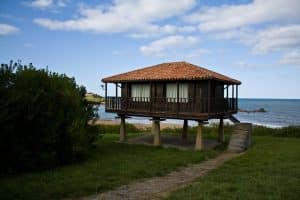Pilgrim Hospitals on the Camino de Santiago begin to gain strength once discovered the tomb of the Apostle SantiagoIn the XNUMXth century, a Pilgrimage Road to Santiago de Compostela began slowly, from all points of Christian Europe.
At the rate that this flow of pilgrims grew, the need was also seen to assist, in every way, this pilgrim tide and especially in the sanitary aspect, due to the hygienic and physical conditions in which its “long pilgrimage”, let us bear in mind that, in many cases, your “Way” could be extended in time for months and even years.
It would not be until the eleventh century, when a first “network of hospital care with a permanent character” was established, directed mainly by religious monastic Orders, supported and endowed by bourgeois, nobles and kings within their respective territories. It should be noted that it was the Benedictine monks who ran the largest number of “Pilgrim Hospitals on the Camino de Santiago”, since care work is one of the main Rules of the Order.
As well detailed in historical references and events that invited this assistance, we can cite the one that appeared in the Codex of the Pretiosa (Roncesvalles): “The door opens to everyone, sick and healthy, both Catholics and pagans , Jews, heretics, idlers, and vain, he already receives everyone as his brothers ”, as well as Chapter XI, of the Codice Calixtino, by Aymeric Picaud:“ Everyone should receive with charity and respect the pilgrims, rich or poor , who return or go to the solar of Santiago, because everyone who receives and hosts them with care, will have as a guest; not only to Santiago, but also to the Lord himself; According to his words in the Gospel: “He who receives you receives Me.” There were once many who incurred the wrath of God for having refused to welcome the poor and the pilgrims of Santiago (…). So it should be known that the pilgrims of Santiago, poor or rich, have the right to hospitality and a respectful welcome “
As a general rule, the assistance offered in the Pilgrims’ Hospitals on the Camino de Santiago was: care for the sick, beggars and pilgrims, especially. This assistance consisted of lodging and food for three meals a day, but depending on the importance and resources available to each Order, this varied very significantly, being able to extend the stay in it, from one night or until the total recovery of the sick or pilgrim The pilgrims of that time could not imagine how with the passing of the years all the calamities of arriving in Santiago would become more bearable with the comforts of a trip to the Camino de Santiago organized.
Among the first Hospitals that were erected in the XNUMXth century, we can highlight on the one hand those of Jaca (Camino Aragonés). On the other hand, Pamplona,
Already in the twelfth century, the Calixtino Codex cites, due to their importance: “the three pilgrim hospitals of the World” (Jerusalem, Mont-Joux and Santa Cristina in Somport -Road of Santiago Aragonés-)
Likewise, the Hospital for Pilgrims founded in Roncesvalles had a special care relevance given the massive pilgrim influx that occurred in this century and for the excellence in the care it provided, as well as the Hospital of the King of Burgos, founded by Alfonso VIII of Castilla and his wife Doña Leonor, with a capacity for about 2000 pilgrims.
In León, also in the XNUMXth century, the first steps were taken for the construction of the Convent of San Marcos, for its use as a pilgrim hospital and religious temple. After many works, over the centuries, this building was the precursor of what is now the Parador Nacional de León, a Renaissance architectural gem.
But, without a doubt, the most significant of all the Pilgrim Hospitals on the Camino de Santiago, was the Hospital Real de Santiago, promoted directly by the Catholic Monarchs in 1499, finishing its construction in 1511 and which was built for the care of pilgrims who were on the Camino de Santiago. The Royal protection meant that the aforementioned Hospital had the most important care facilities of the time, in terms of health, hygiene, food and comfort to offer the thousands of pilgrims who completed their Jacobean pilgrimage in Santiago.
In 1954, this building became the Parador de los Reyes Católicos, an emblematic monument located in the same Plaza del Obradoiro, next to the Cathedral of Santiago, hence the effective and symbolic importance of what was the flagship of the Hospitals of Pilgrims created by and for pilgrims throughout the centuries.









